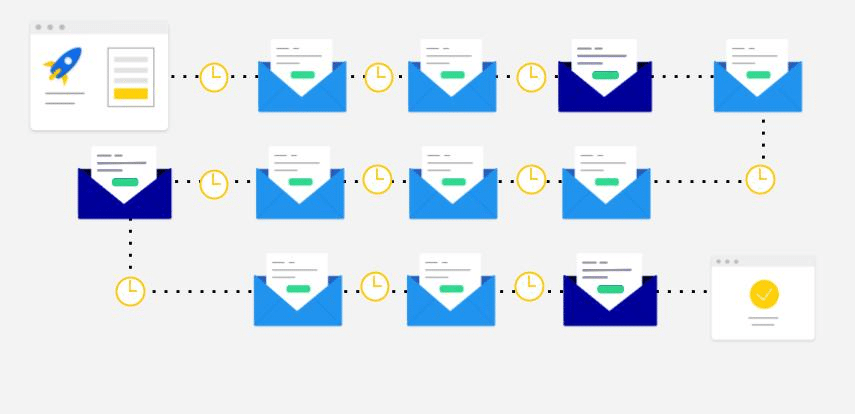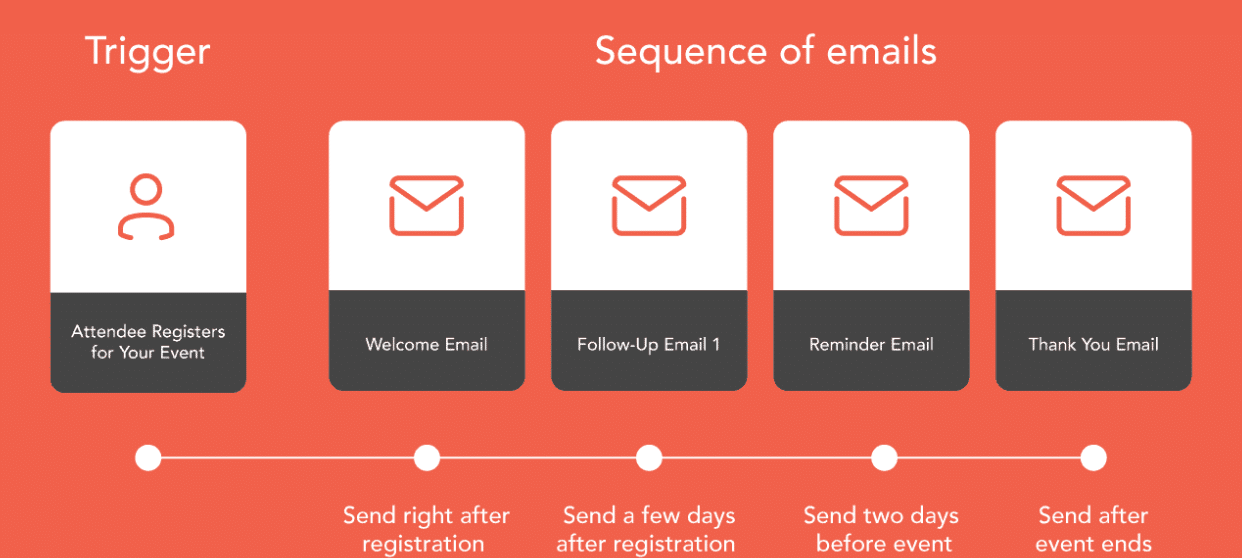In marketing, capturing and nurturing leads is the golden ticket to business growth. Two powerful tools in your arsenal are drip SMS and drip email campaigns. But which one is the real MVP when it comes to lead generation?
Let’s dive in and explore the strengths and weaknesses of each, helping you decide which drip is right for your business.
Is your target audience more likely to check their phone or their inbox? Are you looking for quick engagement or detailed nurturing? Let’s find out!
Why SMS and Email Are Powerful Marketing Channels for Lead Generation
Based on the statistics, SMS and email are both highly effective for lead generation. Here’s a quick overview of the key stats:
| Comparison | SMS | |
|---|---|---|
| Open Rate | 98% | 28% |
| CTR (Click-Through Rate) | 10% | 3.8% |
| Conversion Rate | 29% | 15.22% |
| Read Rate | 42% | 32% |
| ROI (Return on Investment) | $10 for every $1 spent | $42 for every $1 spent |
What is Drip SMS?
Drip SMS for lead generation involves using a series of automated timed text messages to engage and nurture leads throughout their journey with your brand. It’s a series of pre-written text messages that are automatically delivered at specific intervals, designed to nurture leads and guide them toward becoming customers.

Examples of Drip SMS
1. Recover Abandoned Carts
This type of drip SMS is designed to remind customers who have left items in their shopping carts to complete their purchases. It’s a common tactic to increase sales and prevent lost revenue
SMS 1 (Sent immediately after purchase): “Welcome to [Company Name]! We’re excited to have you join. Here’s your login information: [Link]”
SMS 2 (Sent 1 day after purchase): “Don’t forget to check out our [Tutorial/Resource] to get started with [Product Name].”
SMS 3 (Sent 3 days after purchase): “Need help? Our support team is available 24/7. Contact us at [Phone Number] or [Email].”
2. Boost Sales with Cross-Selling
Cross-selling involves suggesting additional products or services to customers based on their previous purchases which can increase average order value and encourage repeat business.
SMS Example: You recently purchased [Product Name]. We think you might also like [Related Product Name]. Check it out now: [Link]”
3. Automate Lead Nurturing
This involves sending a series of SMS messages to leads over time to build relationships and provide valuable information, and guide them toward making a purchase.

SMS Example: (Welcome message) “Hi [Name]! Welcome to [Brand]! Explore our world with 10% off your first order. Use code NEWCUST. [Link to website]”
4. Increase Engagement and Gather Feedback
This type of SMS is used to collect customer feedback, improve customer satisfaction, and build stronger relationships.
SMS Example: “Which color do you prefer for our new t-shirt: blue or green? Reply with A for blue, B for green.”
5. Optimize Campaigns for Maximum Impact
This involves testing different SMS messages to determine which ones perform better. It also includes personalizing messages to make them more relevant to individual customers.
SMS Example: (A/B test) Option A: “Limited time offer! 20% off all dresses.” Option B: “Dress to impress! Shop our new collection and save 20%.”
What is Drip Email?
Drip Email refers to a strategy where automated email campaigns are sent to prospects or leads over time based on specific triggers or timelines. The emails are designed to nurture leads through the sales funnel by providing relevant and timely information that type of approach helps to maintain engagement and guide potential customers toward making a purchase decision.


Examples of Drip Email Campaigns
1. Welcome Series

(Image Source: Link)
The Welcome Series introduces new leads to your brand, setting the stage for ongoing engagement. It includes a series of automated emails that guide new subscribers through the initial steps of using your product or service which builds a positive first impression and provides essential information to get started.
Drip Email Content ideas:
- Company overview
- Product or service highlights
- Exclusive offers or discounts
- Helpful resources (e.g., blog posts, guides)
- Social media links
2. Product Education Series

The Product Education Series is designed to educate leads about the features and benefits of your product. It helps users understand how the product solves their problems and how they can make the most of it. This series is crucial for converting leads by demonstrating the product’s value.

(Image Source: Link)
Drip Email Content ideas:
- How-to guides
- Case studies
- Product comparisons
- Testimonials
- Behind-the-scenes content
3. Lead Nurturing Series
The Lead Nurturing Series focuses on building relationships with leads by addressing their needs, offering valuable content, and guiding them toward a purchase decision. It helps in nurturing leads through personalized communication and targeted offers.

(Image Source: Link)
Drip Email Content ideas:
- Personalized recommendations
- Relevant articles or news
- Limited-time offers or promotions
- Webinar invitations
- Free trials or demos
4. Re-engagement Series
The Re-engagement Series aims to reconnect with leads who have become inactive or have not yet converted. It seeks to reignite their interest by addressing potential barriers and offering incentives to encourage them to re-engage with your brand.

(Image Source: Link)
Drip Email Content ideas:
- Time-sensitive offers
- Personalized product recommendations
- Behind-the-scenes content
- Customer success stories
- Polls or surveys to gather feedback
5. Event-based Series
The Event-based Series promotes upcoming events such as webinars or workshops. It ensures high engagement and attendance by providing detailed information, reminders, and follow-ups related to the event.

(Image Source: Link)
Drip Email Content ideas:
- Event announcements
- Speaker spotlights
- Countdown timers
- Exclusive discounts or early bird pricing
- Post-event follow-up with key takeaways or recordings
Comparing Drip SMS Vs.Drip Email
To get an overview of their features, let’s compare these two methods to help you decide which one is the best fit for your lead generation strategy:
| Features | Drip SMS | Drip Email |
|---|---|---|
| Delivery Speed | Almost instant delivery, typically within seconds | Delivery can take minutes to hours |
| Open Rate | Generally higher; often around 98% | Lower; usually between 15% and 30% |
| Read Rate | Very high; most messages are read within minutes | Varies; may be lower due to spam filters |
| Engagement Rate | High engagement due to immediacy and directness | Varies; dependent on subject lines and content |
| Message Length | Limited to 160 characters per SMS | Longer messages possible, typically up to 2000 characters |
| Cost | Generally lower per message but can add up with high volumes | Higher cost per email, especially with large lists |
| Compliance | Must comply with SMS regulations (e.g., opt-in requirements) | Must comply with email regulations (e.g., CAN-SPAM Act) |
| Analytics | Basic analytics (e.g., delivery, open rates) | Detailed analytics available (e.g., open rates, click-through rates, conversions) |
| Customer Preference | Some customers prefer SMS for its immediacy | Many customers prefer email for detailed content |
| Opt-Out Mechanism | Requires clear opt-out instructions, often through reply STOP | Usually includes an unsubscribe link; easier for users to opt-out |
| Lead Nurturing | Effective for short-term nurturing and immediate engagement | Better for long-term nurturing with detailed and segmented content |
When to Use Drip SMS vs. Drip Email
As we know drip marketing is a strategy that involves sending a series of automated messages to leads over time. Both SMS and email can be used for this purpose, but each has its own strengths and weaknesses.
When to Use Drip SMS
Drip SMS is generally more effective when:
- SMS messages are typically opened within a few minutes of being received, making them ideal for time-sensitive offers, such as limited-time discounts or flash sales.
- If you want leads to take a specific action right away, such as confirming an appointment or downloading a resource, SMS is a great option.
- When You’re targeting a younger demographic because Younger generations tend to prefer SMS over email, as it’s more aligned with their communication habits.

When to Use Drip Email
Drip email is typically used in the following scenarios:
When You Need to Provide Detailed Information: Emails can contain more content than SMS messages, making them ideal for sharing in-depth product information, educational resources, or case studies.
When You’re Building Relationships Over Time: Drip email campaigns can be used to nurture leads over a longer period, gradually building trust and familiarity with your brand.
When You’re Targeting a More Mature Audience: Older generations may be more accustomed to receiving information via email.
Conclusion:
While both Drip SMS and Drip Email offer effective ways to nurture leads and drive conversions still the optimal choice ultimately depends on your specific marketing objectives and target audience.
So, which one is right for you? Experiment, analyze your results, and tailor your strategy to maximize your lead generation efforts.
Keep the conversation going…
Over 10,000 of us are having daily conversations over in our free Facebook group and we’d love to see you there. Join us!

